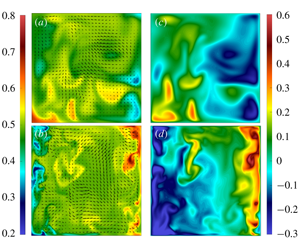Article contents
Weak formulation and scaling properties of energy fluxes in three-dimensional numerical turbulent Rayleigh–Bénard convection
Published online by Cambridge University Press: 19 December 2019
Abstract

We apply the weak formalism on the Boussinesq equations to characterize scaling properties of the mean and the standard deviation of the potential, kinetic and viscous energy fluxes in very well-resolved numerical simulations. The local Bolgiano–Oboukhov (BO) length is investigated and it is found that its value may change by an order of magnitude through the domain, in agreement with previous results. We then investigate the scale-by-scale averaged terms of the weak equations, which are a generalization of the Kármán–Howarth–Monin and Yaglom equations. We have not found the classical BO picture, but evidence of a mixture of BO and Kolmogorov scalings. In particular, all the energy fluxes are compatible with a BO local Hölder exponent for the temperature and a Kolmogorov 41 for the velocity. This behaviour may be related to anisotropy and to the strong heterogeneity of the convective flow, reflected in the wide distribution of BO local scales. The scale-by-scale analysis allows us also to compare the theoretical BO length computed from its definition with that empirically extracted through scalings obtained from weak analysis. Scalings are observed, but over a limited range. The key result of the work is to show that the analysis of local weak formulation of the problem is powerful to characterize the fluctuation properties.
JFM classification
- Type
- JFM Papers
- Information
- Copyright
- © 2019 Cambridge University Press
References
- 9
- Cited by


